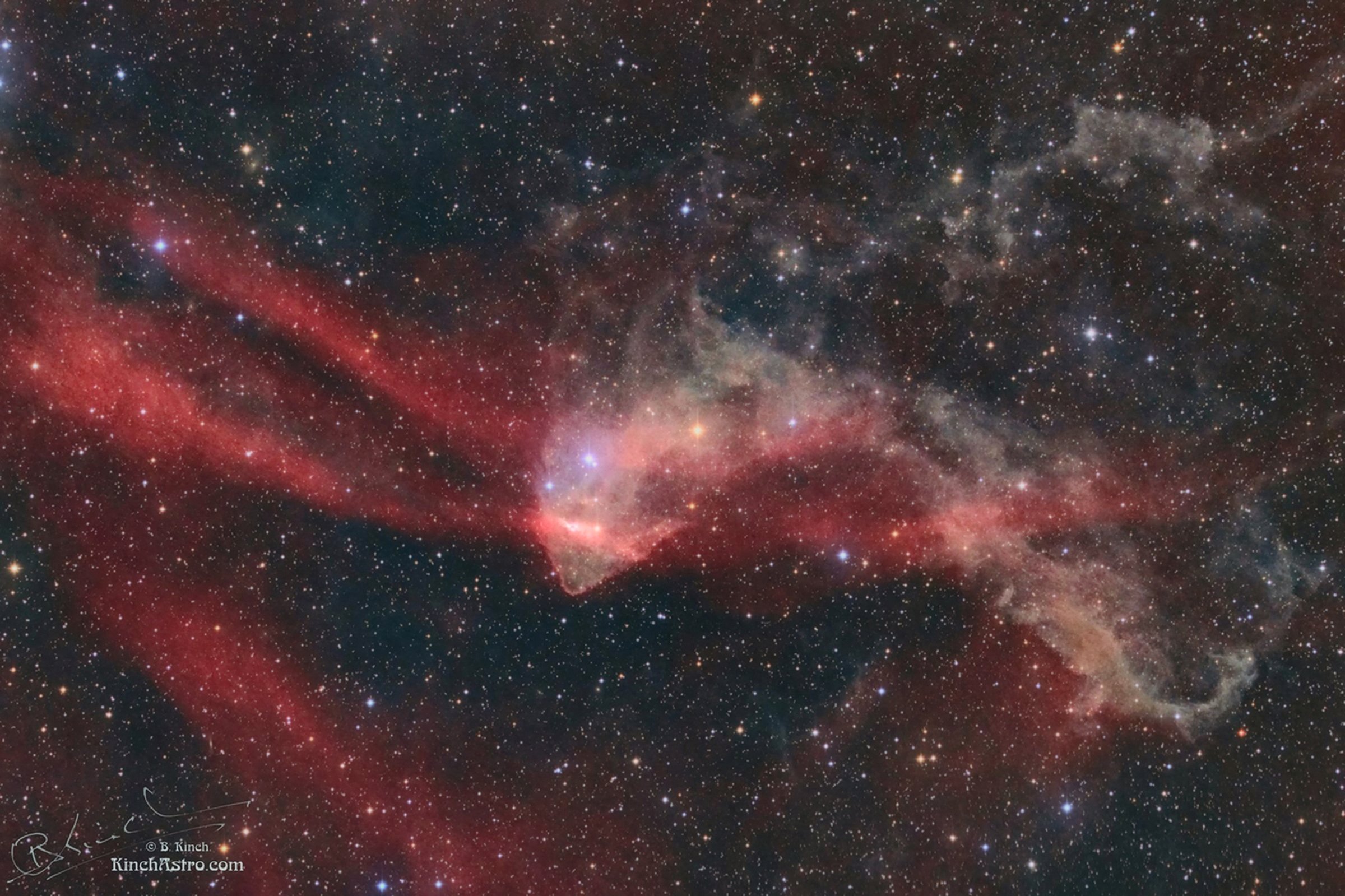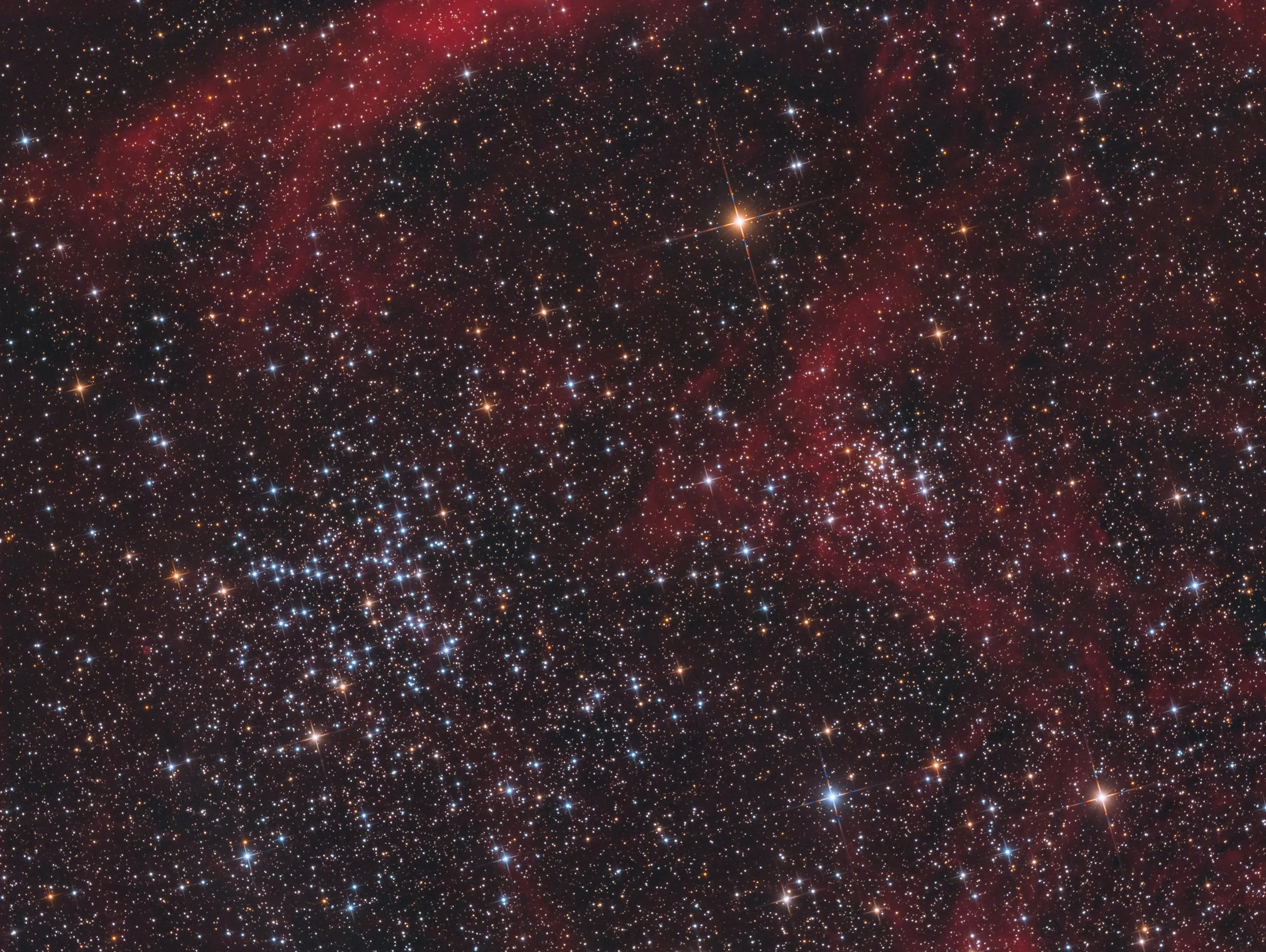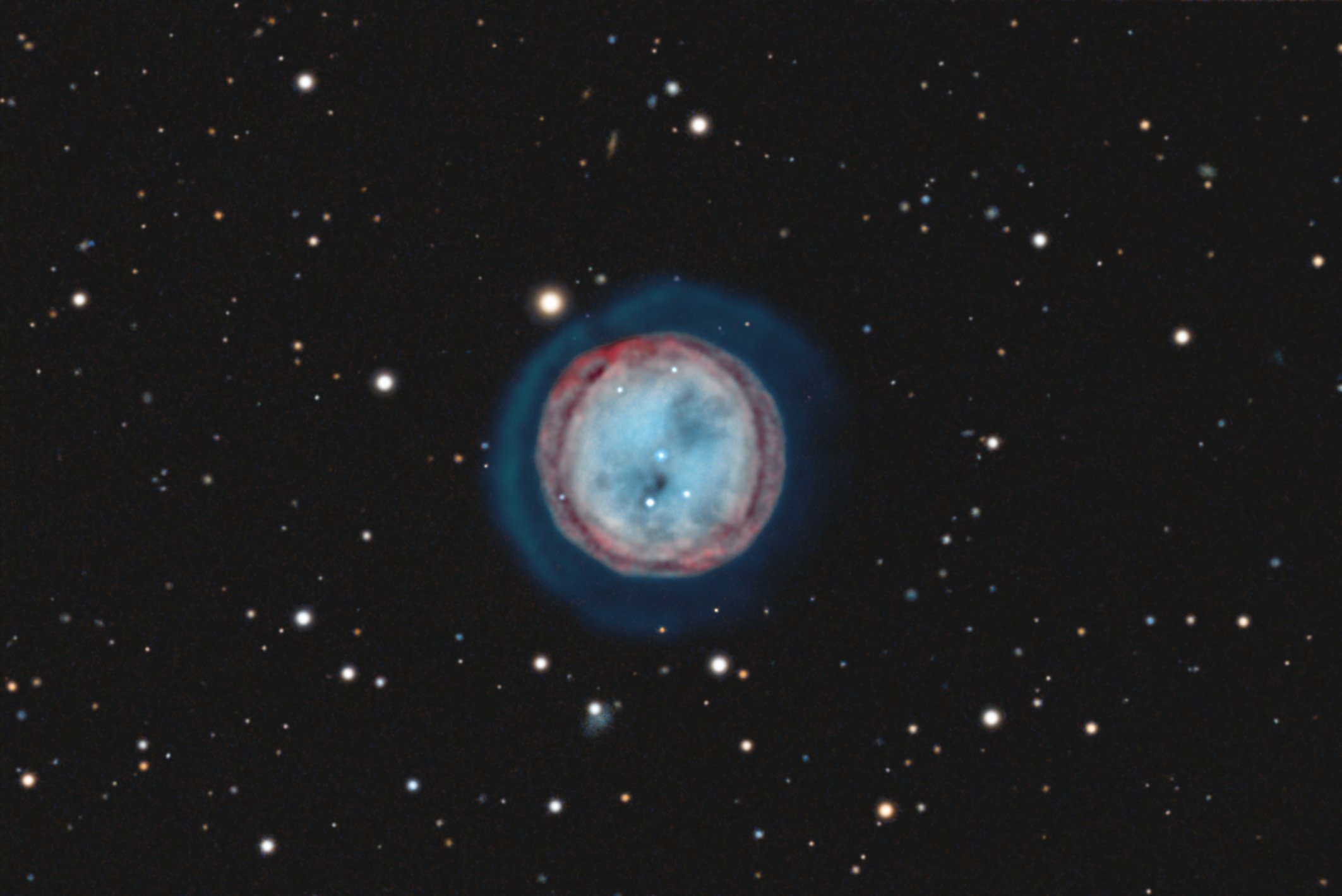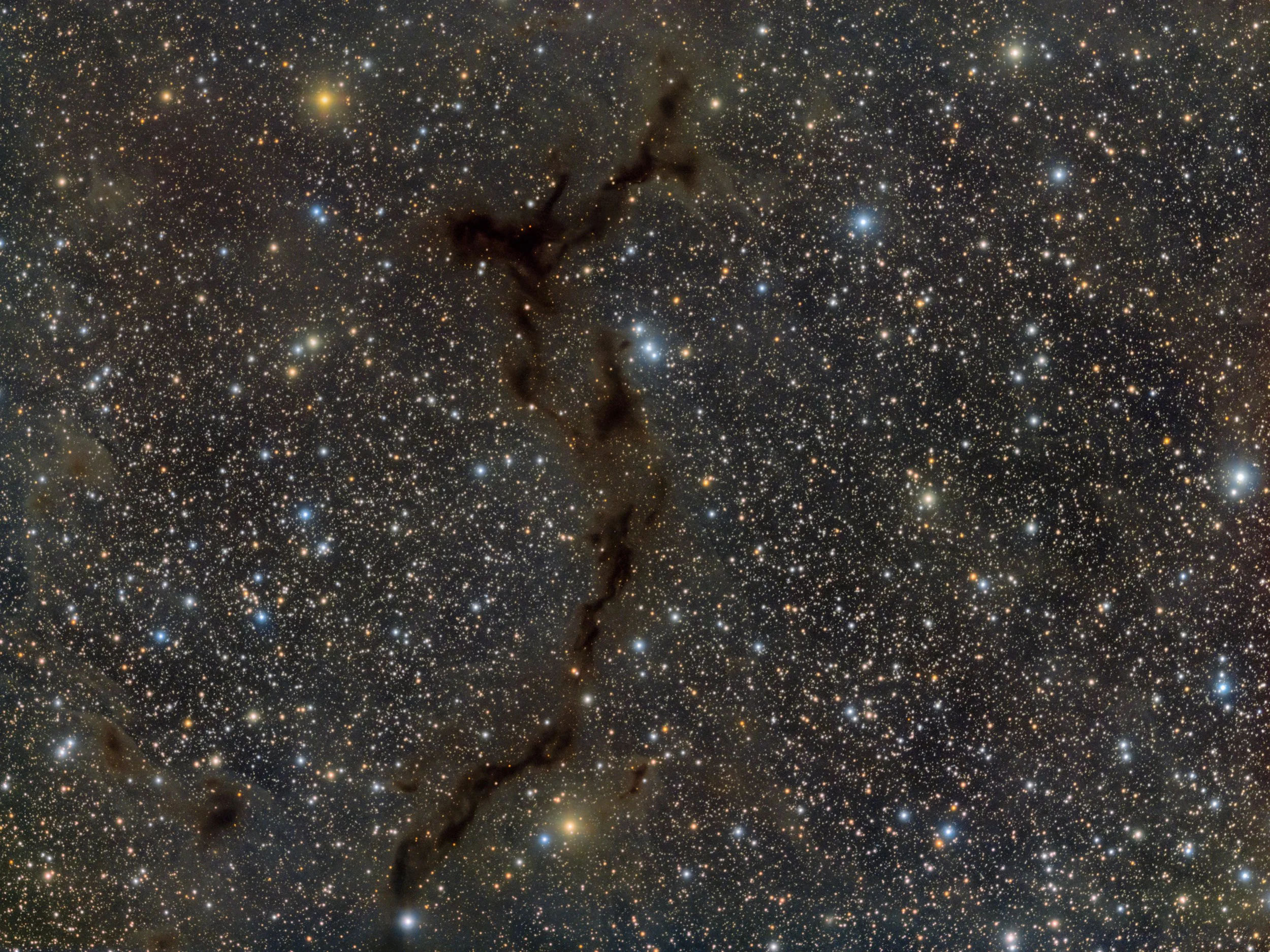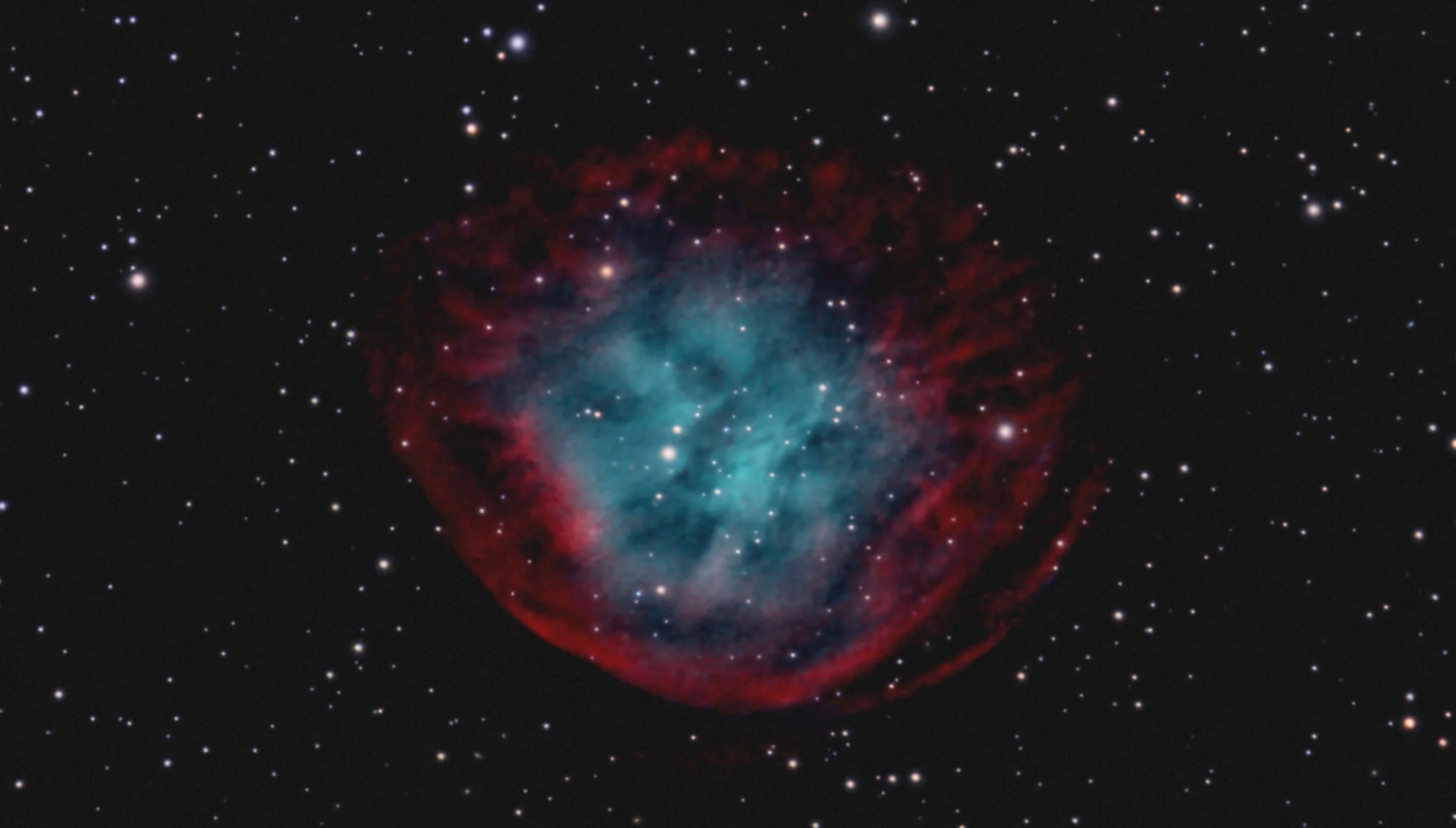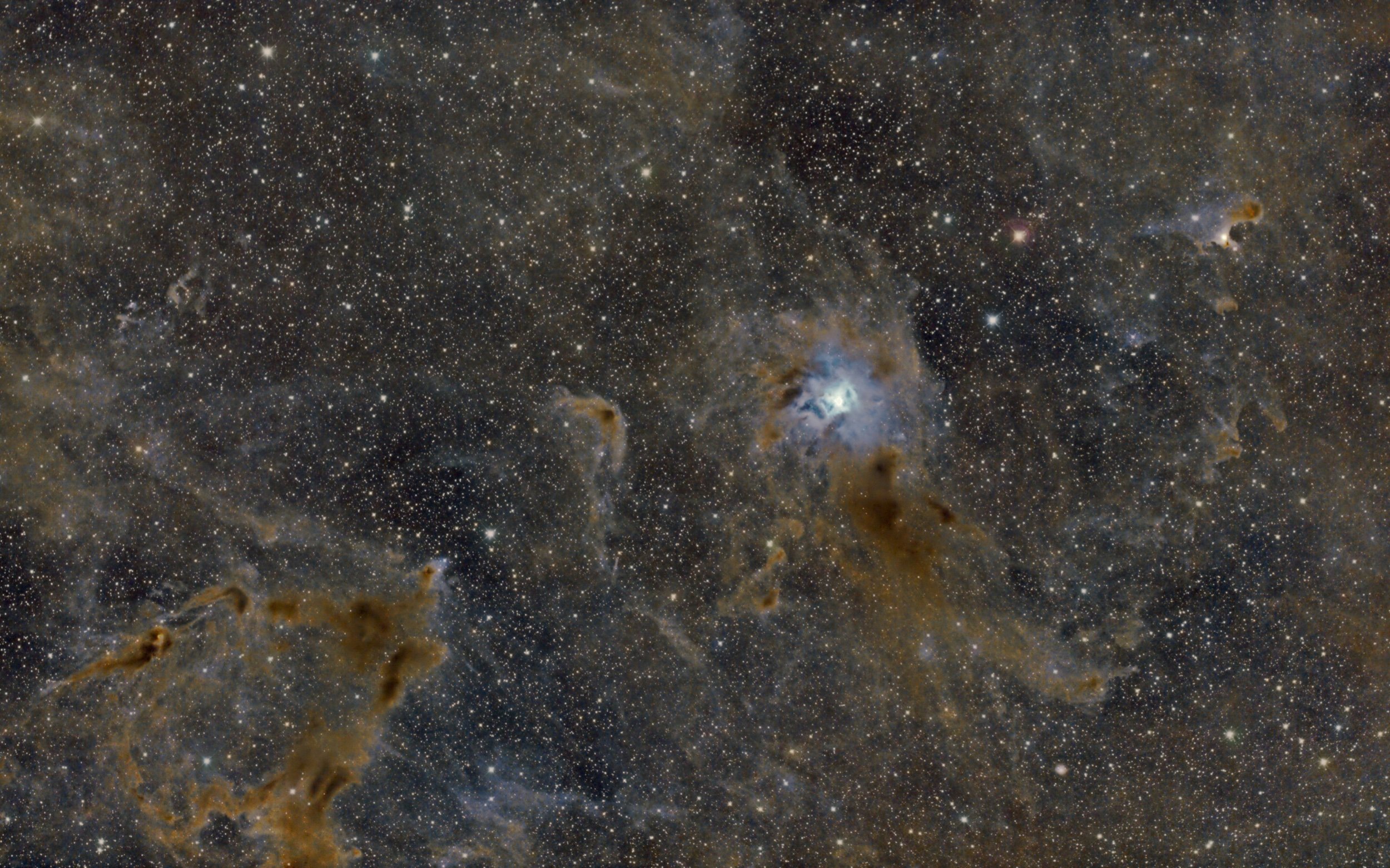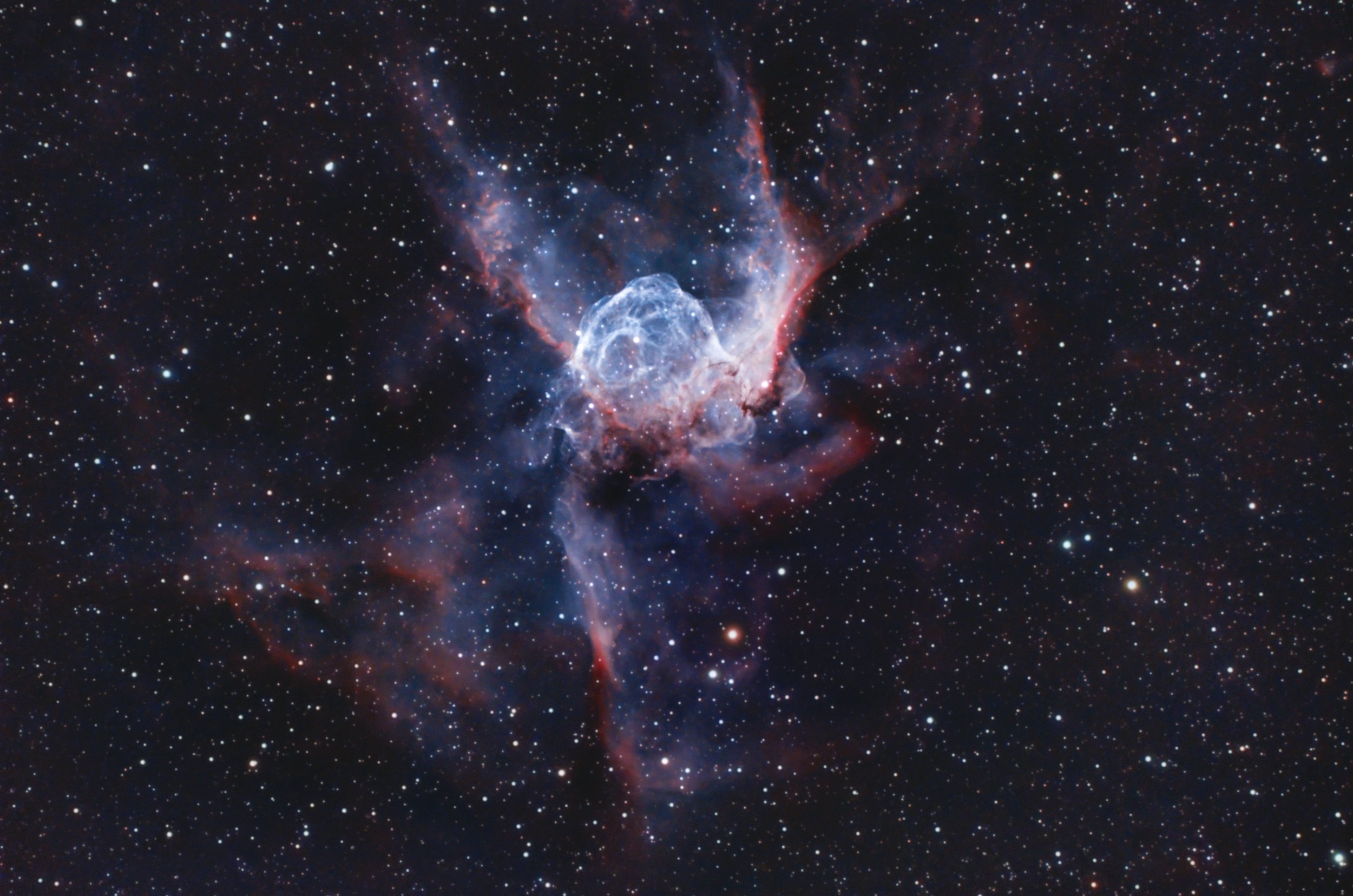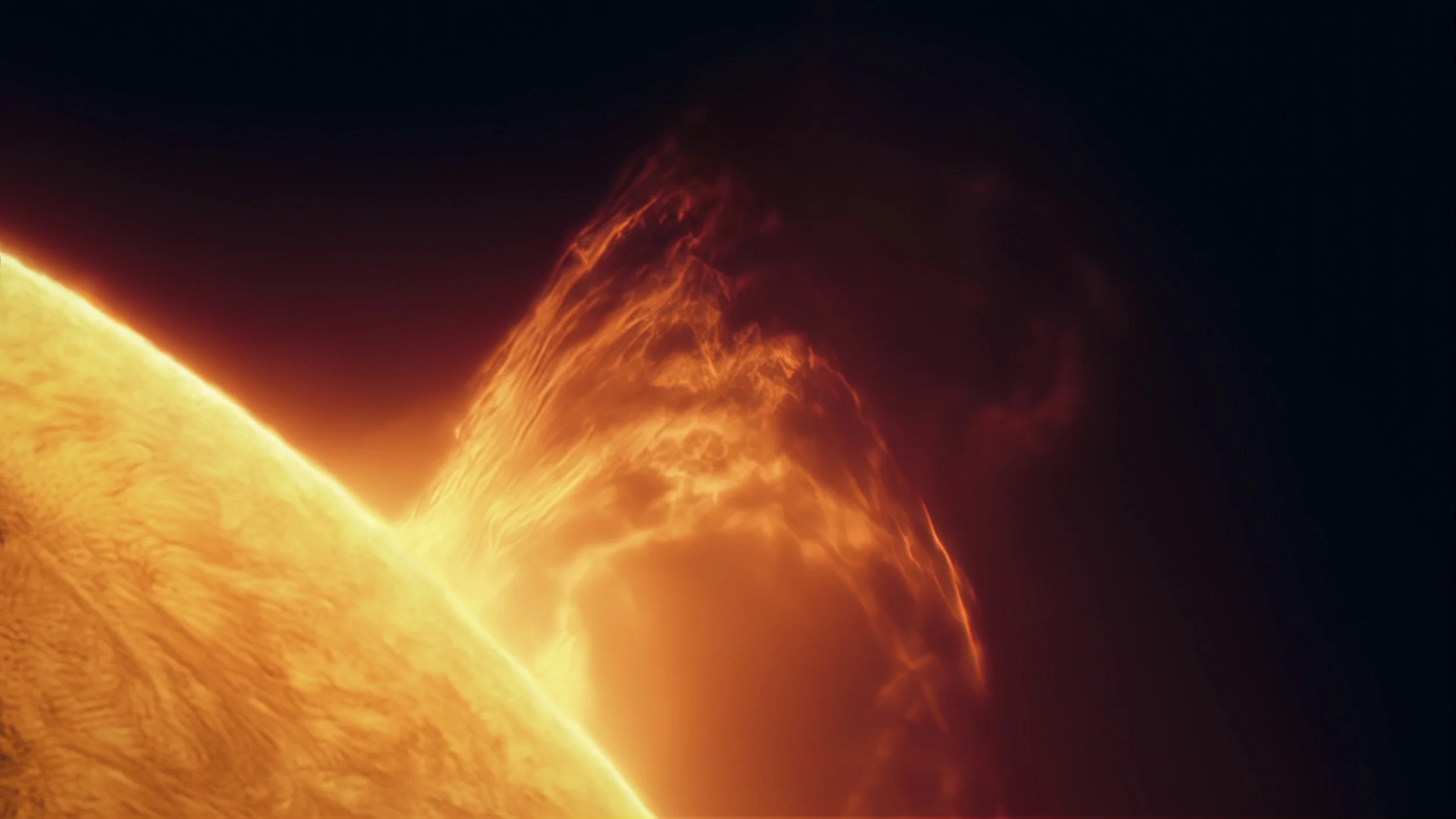
AAPOD2 Image Archives
LBN 437 (SH2-126)
Image Description and Details : Data reprocessed under cloudy skies in March '22
LBN 437 is a molecular cloud in the constellation Lacerta. It is located at the edge of the much larger emission nebula Sh2-126 and the star forming region Lacerta OB1. The densest part of LBN 437 (centre) is associated with some bright young stars, among which the variable star V375 Lacertae, which is an Herbig object, with strong Hα-emission. This star is also responsible for the excitation of some bipolar Herbig-Haro-Objects situated in the nebula (HH 808, HH 809, HH 398).
Imaging telescope: Takahashi FSQ130ED
Imaging cameras: FLI ML16200
Mounts: Takahashi EM 400 Temma 2M
Guiding cameras: QHY CCD QHY 5 II
Focal Extender / Reducer: Tak QE 0.73x
Software: PHD 2, Astro Pixel Processer, PixInsight , Sequence Generator Pro SGP
Filters: Astrodon Ha + Astrodon RGB
Accessories: ATIK EFW3
Dates: Oct 4 - Oct 9, 2021
Frames:
Astrodon Ha: 18 x 600"
Astrodon R: 26 x 180"
Astrodon G: 26 x 180"
Astrodon B: 28 x 180"
Astrodon L: 57 x 180"
Integration: 8 Hours 51 Mins.
Copyright: Brendan Kinch
M38 & NGC1907
Image Description and Details : Image was taken over 6 Nights in Marchz with192 Singelframes a 300 Secounds with my QHY268c and my ASI1600pro for Ha
Lacerta 800mm Newton
Mgen3
Lacerta Mfoc
EQ6R
N.I.N.A, Pixinsight, Photoshop.
Copyright: Jan Schubert
An Owl with a Halo
Image Description and Details : Messier 97 - a planetary nebula in Ursa Major sporting its faint OIII Halo. It is approximately 2,030 light years from Earth.
I was pleased to be able to tease out some of the structure of the faint outer OIII halo - especially as most of the OIII data was captured from my Bortle 8 sky in London because Spain has been clouded out for the past month.
Image captured on my remote dual rig at Fregenal de la Sierra in Spain and my C11 telescope in London between 14 January - 24 March 2022.
Scopes: APM TMB LZOS 152 Refractors, C11 reflector
Cameras: QSI6120wsg8, QSI683wsg8
Mounts: 10Micron GM2000 HPS, 10 Micron GM1000 HPS
A total of 48 hours 55 minutes image capture (HaOIIILRGB)
Copyright: Peter Goodhew
Auroras over Saana
Image Description and Details :
I booked a small holiday trip to Kilpisjärvi, Finland with a friend of mine. We walked around the nearby lake just in front of the saana fell (1029m) and waited around 4 hours to some auroras to appear. The parameters were quiet, but still had some minor activity and I was confident that it would spark a small show which is why we waited so long. Around midnight the wait was rewarded with a great half-sky display. Sony A7S, Sigma art 14mm f/1.8.ISO 4000, 0.5 seconds
Copyright: Dennis Lehtonen
Messier 106
Tierra del Sol, CA (San Diego Astronomy Association's dark site)
70 East of San Diego
Telescope: Celestron C11
Focal length: 1800mm @ f6.3
Starizona SCT Reducer/Corrector
Mount: CGX
Camera: ASI294MC-P
Filters: Optolong L-eNhance/UVIR cut
Autoguiding: Celestron OAG
Guide camera: ASI174mm mini
Integration time: 20 hours (10 each filter)
Exposure time: 120 seconds
Calibration: 50 Darks, 30 Flats/Dark Rlats
Bortle 5
Software:
NINA
PHD2
PixInsight
Copyright: Ralph MacDonald
The Seahorse Nebula
Image Description and Details : This dark nebula lies at a distance of 1200 light-years from Earth in the Constellation of Cepheus. Because the nebula is in the Milky Way's plane it stand outs from the background filled with colourful stars of our galaxy, a keen eye can also distinguish three separate dense dust cores that actually are star formation regions.
Taken from my self-built remote observatory in Finland with SkyWatcher Esprit 100mm f/5.5, ZWO ASI1600MM-C, Losmandy G11, guided with ASI224MC as finder-guider, TS Optics LRGB filters.
L: 262x120s, R: 92x120s, G: 100x120s, B: 80x120s.
Total integration time is ~18 hours.
Copyright: © Ville Miettinen
Abell 31
Image Description and Details : Abell 31
An evolved planetary nebula in the constellation Cancer. It is estimated to be 2,000 light years from Earth.
TARGET
Nomenclature: Abell 31
Right Ascension: 08:54:13.20
Declination: +08.53.53.02
Size: 970 arc secs
EQUIPMENT USED
Twin APM TMB LZOS 152 refractors
10Micron GM2000 HPS mount
Twin QSI6120 CCD cameras
Astrodon filters
IMAGE CAPTURE
Blue: 10x300"
Green: 24x300"
Red: 27x300"
Ha: 76x900" bin 1x1
OIII: 76x900" bin 1x1
Total Integration: 43 hours 5 minutes
Pixel scale: 0.531 arcsec/pixel
Field radius: 0.357 degrees
Capture dates: 28 February - 9 March 2022
Capture location: Fregenal de la Sierra, Spain
IMAGE PROCESSING:
CCDStack2 and Photoshop CS2
Copyright: Peter Goodhew
Iris Nebula wide field
Image Description and Details : Image Description and Details : NGC7023 - SH2-136 - LBN475 - LBN468
Takahashi Espilon 130D
Canon 6Da
SkyWatcher EQ6-Pro
intégration: 230x180" (11h 30')
Copyright: Thierry BOUFFLET
Markarian's chain & IFN
Image Description and Details : Reworking of a previous photo highlighting the NFI that characterizes the cluster of the Virgin.
The IFN (Integrated Flux Nebulae) are huge systems of very faint and faint filaments nebulae predominantly not illuminated belonging to the high Galactic latitudes of the Milky Way.
The most extensive system of this type extends along all the northern constellations of the northern celestial hemisphere reaching even the Polar star.
These nebulae have in common the fact that they are not illuminated by a single star but by all the stars of the Milky Way in the vicinity.
Their visibility is conventionally divided between very Bright (those close to M81 and M82), Medium, Faint (weak, as in the case of the Markarian's chain) and dim (poor).
The IFN present in the Markarian cluster is however rather surprising both for its distance from the galactic plane and for its relative brightness although defined as very poor in the details.
Copyright: Giambattista Rizzo
NGC 2841 | A Galaxy Headed For Retirement
Image Description and Details : Having lost most of its star forming hydrogen clouds, NGC 2841 is domintated by mature yellow and red stars. Several encircling rings of dust can just be seen here about doubling the apparant diameter of the otherwise 8' disk. Extreme stretches also show a very faint arm trailing off to the right. This arm might suggest some galacitc interaction, but that seems at odds with such a lack of star formation. Maybe the interaction was a long time ago or very limited? The Ha data I shot confirms the lack of HII emissions.
41 total hours about half in Luminance. A super luminance was used with the RGB masters to try and tease out the outer rings. My Bortle 3 site may be at the limit to capture these. My FHWM cut off was over 3" to keep integration time high. To add sharpness to the galaxy detail I did a second Luminance with a 2.4" cutoff and blended that with a mask.
Planewave CDK14, Planewave L-350, QHY600M
Copyright: Kevin Morefield
47 Tucanae
Image Description:
Location: Rio Hurtado, Chile
Telescope: ASA 500N
Camera: FLI PL16803
Mount: ASA DDM85
Red: 7x10 minutes (binned 1x1)
Green: 6x10 minutes (binned 1x1)
Blue: 7x10 minutes (binned 1x1)
Copyright 2022 Bernard Miller
4 dust monsters
During our stay at the observatory, I had a little bit left at the end of the night after our collaboration, so I took the opportunity to take a walk in this dusty area of the sky that had been watching me for a while. I was able to shoot it properly during this moonless weekend.
I really wanted to highlight this epic fight scene between 4 dust monsters, LDN 1228, LBN 550, LBN 552 and LBN 555, that's why I went with this diagonal framing to make it look like one takes over in this battle.
I also wanted to respect the natural colors which I find really beautiful and which accentuate this duality with the bluish and orange hues like ice and fire.
Shot on February 3, 27 and 28, 2022.
Takahashi FSQ106 EDX4 with 645-QE super reducer
Asi 2600MM Pro
Antlia LRGB filters
Eq6r-pro
Altaïr 60/225 guide + asi 290mm mini
L: 130x300''
R - G -B: 25x300'' per filter
Stars: 90x15'' per filter
Bortle sky 4
Acquired: N.I.N.A + Phd2
Processing: Siril + PixInsight + Photoshop
Copyright: Yann Sty
Bergkirchli
In February, I spent a two week skiing vacation in Arosa, Switzerland. Repeated snowfall made for some of the best snow conditions in years. The drawback was that I only got one clear night for astrophotography during my entire stay.
I decided to spend that night at the Bergkirchli (Mountain Chapel). Built in 1493, one year after Kolumbus discovered America, the chapel is the oldest building of Arosa. I found that it aligns nicely with the Winter Milky Way and Orion.
EXIF
Canon EOS Ra
Sigma 28mm f/1.4
IDAS NBZ filter
iOptron SkyTracker Pro
Sky:
Two panel vertical panorama, each a stack of 20x 30s @ ISO800, f/2, unfiltered + 6 x 120s @ ISO3200, f/1.4, filtered
Foreground:
Stack of 3 x 30s @ ISO400, f/11 during blue hour.
Copyright: Ralf Rohner
Gyulbudaghian nebula
I share with you my last take, it is an area that contains several dark nebulae, LDN1158, LDN1157, LDN1148 and LDN1155 among others, an object also called the Gyulbudaghian nebula, named after the Armenian astronomer Armen Gyuldubaghian who discovered it in 1977.
Acquisitions: 26h
March 7,8,9 and 10
L 207x300 - R 36x300 - V 36x300 - B 36x300
Materials:
Takahashi FSQ 85 EDX Takahashi Flattener 1.01x
ZWO ASI294MM Pro Camera
Mount Ioptron cem70
Astrodon Tru-Balance E-Series Gen 2 LRGB Filters
ZWO OAG Off Axis Guider and ZWO ASI290MM
ZWO asianair pro
Calibration: Siril 1.0.0-rc2
Pre-processing/processing: PixInsight and Photoshop
Copyright: Christophe Vergnes
Thor's Helmet - NGC 2359
Image Description and Details :
Thor's Helmet - NGC 2359 Thor's Helmet, an emission nebula ~11,960 light years away, is in the constellation Canis Major. The central star is the Wolf-Rayet star WR7, a star thought to be in a brief pre-supernova stage of evolution. Acquisition: Location: Queen Creek, AZ Bortle 7 Date: 2022-02-26 - 2022-03-11 Lights (Dithered, Cooled 0°C, Gain 100): 199 x 180s Darks: 25 Flats: 25 Dark Flats: 25Hardware: Camera: ZWO ASI 2600MC PRO Scope: Celestron EdgeHD 11" Focal Reducer: Celestron 0.7x Focuser: Prodigy Microfocuser Guide Camera: Unguided Guide Scope: Unguided Mount: GM2000 HPS II Filter: Optolong L-EnhanceSoftware: SGP Pixinsight PhotoshopProcessing: Stacked in Pixinsight (WBPP, SubframeSelector, DrizzleIntegration) Pixinsight (DCrop, ABE, PhotometricCC, EZDenoise, EZSoftStretch, EZStarReduction, StarNet2)) Gradient removal using GradientXterminator Camera Raw Filter in Photoshop AstroFlat Pro Color/Levels Adjustments
Copyright: James Hawks
The Sun is Boss
Image Description and Details : Captured from Perth Western Australia, using a Skywatcher 127 Maksutov, with an IR/UV Cut filter covering the objective lens,
and a Daystar Quark Chromosphere Solar filter before the camera.
Approx 1500mm F/L.
Composite of two separate exposures.
Lower exposure for the Suns Chromosphere, slightly higher exposure for the Prom.
Incidently, the main prom size reaches out roughly 180,000km. you can see a faint afterburn which continues for approx another 80,000km.
Measurements based on suns diameter and curvature, derived from a full disc image of this event.
Copyright: Copyright: David Gray
Abell 1656 The Coma Cluster
Image Description and Details :
The fantastic Coma Cluster (Abell 56) located 330 millions light-years away in Coma Berenice contains over 1000 identified galaxies. Along with the Leo Cluster (Abell 1367), it is one of the two major clusters comprising the Coma Supercluster.The central region is dominated by two supergiant elliptical galaxies : NGC4874 and NGC4889, and as is usual for clusters of this richness, the galaxies are overwhelmingly elliptical, with only a few spirals of younger age near the outskirts of the cluster.I wanted to capture this object for a long time and I'm glad I could do it from my downtown Bortle 6-7 sky.Newton 250mm f/4 on IOPTRON CEM70 mountCamera ZWO ASI2600mm + Antlia LRGB filters23h50 exposures in February and March 2022 from my backyard.L : 232 x 300sRGB : each 18x300sProcessed with Pixinsight and Photoshop
Copyright: Mathieu Guinot
NGC 5054 “Gem in Virgo”
NGC 5054 is a beautiful spiral galaxy in the Virgo constellation. The galaxy is small in the field of view at an apparent 4×2’. The galaxy has an irregular shape with two of the arms bending back around the galaxy. This small but relatively bright galaxy and allows a reasonable amount of detail and color to come through. This is amazing when you consider that the light from this galaxy has been travelling for 82 million years towards us. The dust lanes are quite evident, as are the star forming areas of the two major spiral arms. These are within the bluish regions of the arms. Its irregular shape suggests a possible interaction in the past.
The background is littered with hundreds of small galaxies. You can go to website to see wider version.
Imaged in LRGB on a Planewave CDK 1000 at El Sauce, Obstech, Chile
Integration Time: 28 hours
Copyright: Mark & Mike
Running Chicken Nebula
The Lambda Centauri Nebula or the λ Centauri Nebula, is an open cluster with an associated emission nebula found in the constellation Centaurus Narrowband image of IC 2948. Data courtesy of Telescope live.
Telescope CHI-1 Planewave CDK-24 Camera FLI ProLine PL9000 Location Location El Sauce Observatory, Rio Hurtado, Chile Date of observation Date of observation 25-12-2021 Filters Filters Astrodon 3nm narrowband
Processing PixInsight & PS
Copyright: Paul Swift

